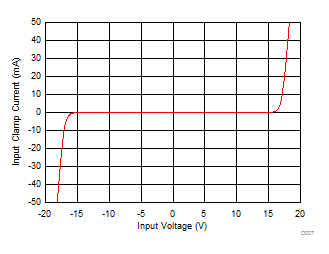SBASA81B January 2023 – October 2024 ADS9815 , ADS9817
PRODUCTION DATA
- 1
- 1 Features
- 2 Applications
- 3 Description
- 4 Pin Configuration and Functions
- 5 Specifications
- 6 Detailed Description
- 7 Register Map
- 8 Application and Implementation
- 9 Device and Documentation Support
- 10Revision History
- 11Mechanical, Packaging, and Orderable Information
Package Options
Mechanical Data (Package|Pins)
- RSH|56
Thermal pad, mechanical data (Package|Pins)
- RSH|56
Orderable Information
6.3.1.1 Input Clamp Protection Circuit
The ADS981x features an internal clamp protection circuit on each of the eight analog input channels, see Figure 6-1. The input clamp protection circuit allows each analog input to swing up to a maximum voltage of ±18V. Beyond an input voltage of ±18V, the input clamp circuit turns on and still operates from the single 5V supply. Figure 6-2 shows a typical current versus voltage characteristic curve for the input clamp.
For input voltages above the clamp threshold, make sure that the input current never exceeds ±10mA. A resistor placed in series with the analog inputs is an effective way to limit the input current. In addition to limiting the input current, the series resistor can also provide an antialiasing, low-pass filter (LPF) when coupled with a capacitor. Matching the external source impedance on the AINxP and AINxM pins cancels any additional offset error.
 Figure 6-2 Input Protection Clamp
Profile, Input Clamp Current vs Source Voltage
Figure 6-2 Input Protection Clamp
Profile, Input Clamp Current vs Source Voltage